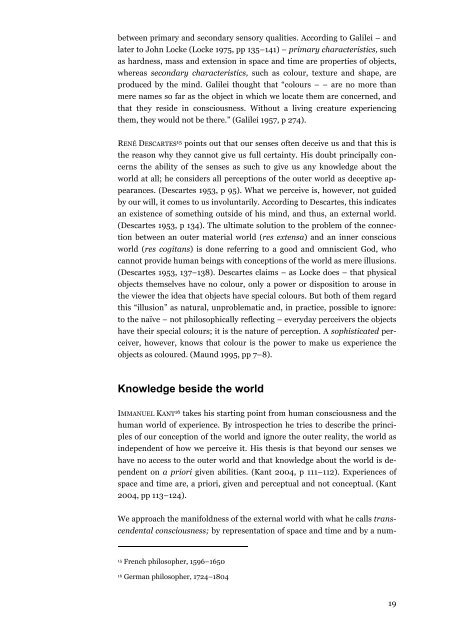Lightness and Brightness and Other Confusions
Lightness and Brightness and Other Confusions
Lightness and Brightness and Other Confusions
You also want an ePaper? Increase the reach of your titles
YUMPU automatically turns print PDFs into web optimized ePapers that Google loves.
etween primary <strong>and</strong> secondary sensory qualities. According to Galilei – <strong>and</strong><br />
later to John Locke (Locke 1975, pp 135–141) – primary characteristics, such<br />
as hardness, mass <strong>and</strong> extension in space <strong>and</strong> time are properties of objects,<br />
whereas secondary characteristics, such as colour, texture <strong>and</strong> shape, are<br />
produced by the mind. Galilei thought that “colours – – are no more than<br />
mere names so far as the object in which we locate them are concerned, <strong>and</strong><br />
that they reside in consciousness. Without a living creature experiencing<br />
them, they would not be there.” (Galilei 1957, p 274).<br />
RENÉ DESCARTES 15 points out that our senses often deceive us <strong>and</strong> that this is<br />
the reason why they cannot give us full certainty. His doubt principally concerns<br />
the ability of the senses as such to give us any knowledge about the<br />
world at all; he considers all perceptions of the outer world as deceptive appearances.<br />
(Descartes 1953, p 95). What we perceive is, however, not guided<br />
by our will, it comes to us involuntarily. According to Descartes, this indicates<br />
an existence of something outside of his mind, <strong>and</strong> thus, an external world.<br />
(Descartes 1953, p 134). The ultimate solution to the problem of the connection<br />
between an outer material world (res extensa) <strong>and</strong> an inner conscious<br />
world (res cogitans) is done referring to a good <strong>and</strong> omniscient God, who<br />
cannot provide human beings with conceptions of the world as mere illusions.<br />
(Descartes 1953, 137–138). Descartes claims – as Locke does – that physical<br />
objects themselves have no colour, only a power or disposition to arouse in<br />
the viewer the idea that objects have special colours. But both of them regard<br />
this “illusion” as natural, unproblematic <strong>and</strong>, in practice, possible to ignore:<br />
to the naïve – not philosophically reflecting – everyday perceivers the objects<br />
have their special colours; it is the nature of perception. A sophisticated perceiver,<br />
however, knows that colour is the power to make us experience the<br />
objects as coloured. (Maund 1995, pp 7–8).<br />
Knowledge beside the world<br />
IMMANUEL KANT 16 takes his starting point from human consciousness <strong>and</strong> the<br />
human world of experience. By introspection he tries to describe the principles<br />
of our conception of the world <strong>and</strong> ignore the outer reality, the world as<br />
independent of how we perceive it. His thesis is that beyond our senses we<br />
have no access to the outer world <strong>and</strong> that knowledge about the world is dependent<br />
on a priori given abilities. (Kant 2004, p 111–112). Experiences of<br />
space <strong>and</strong> time are, a priori, given <strong>and</strong> perceptual <strong>and</strong> not conceptual. (Kant<br />
2004, pp 113–124).<br />
We approach the manifoldness of the external world with what he calls transcendental<br />
consciousness; by representation of space <strong>and</strong> time <strong>and</strong> by a num-<br />
15<br />
French philosopher, 1596–1650<br />
16<br />
German philosopher, 1724–1804<br />
19
















